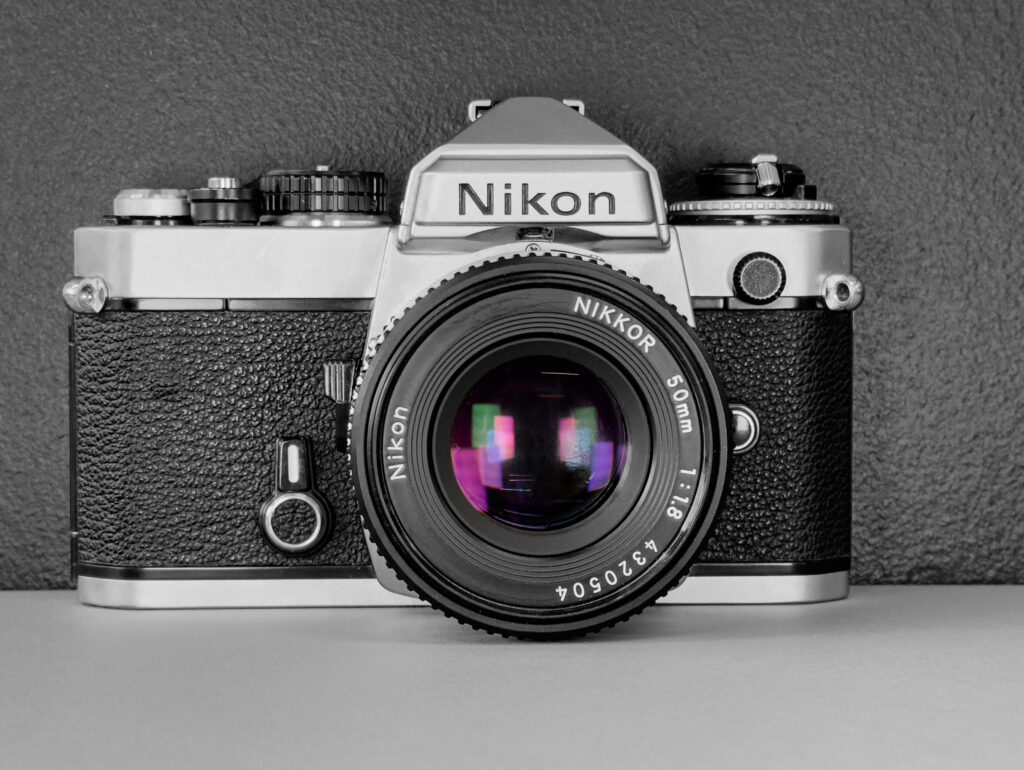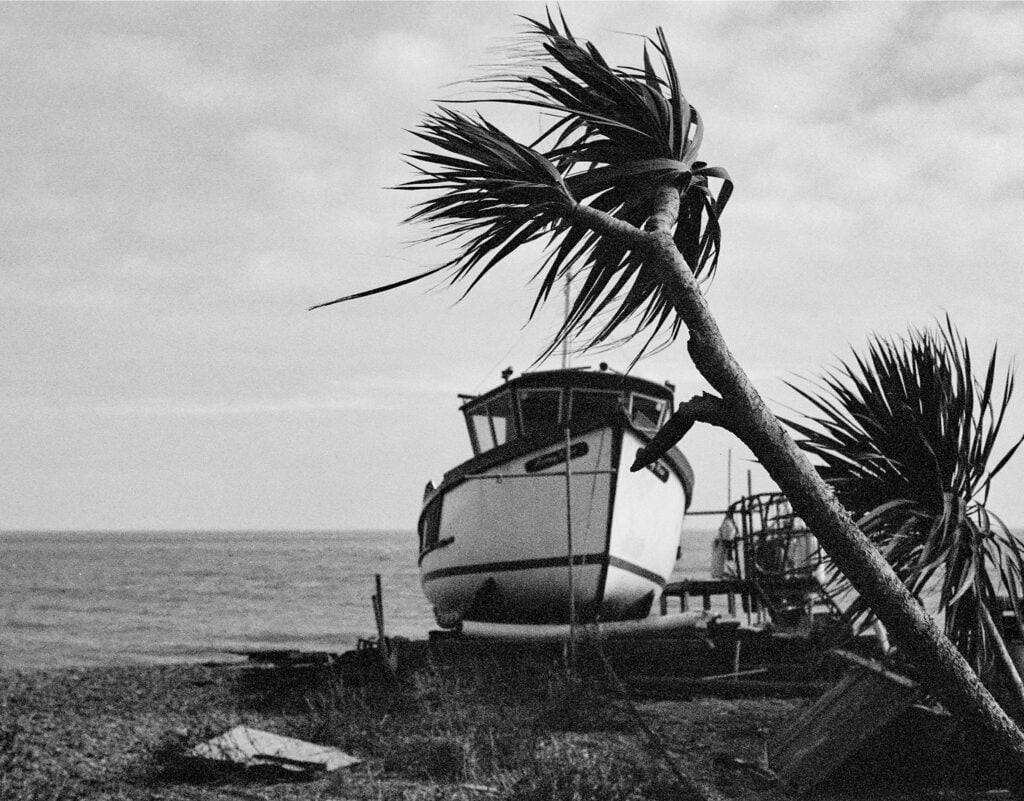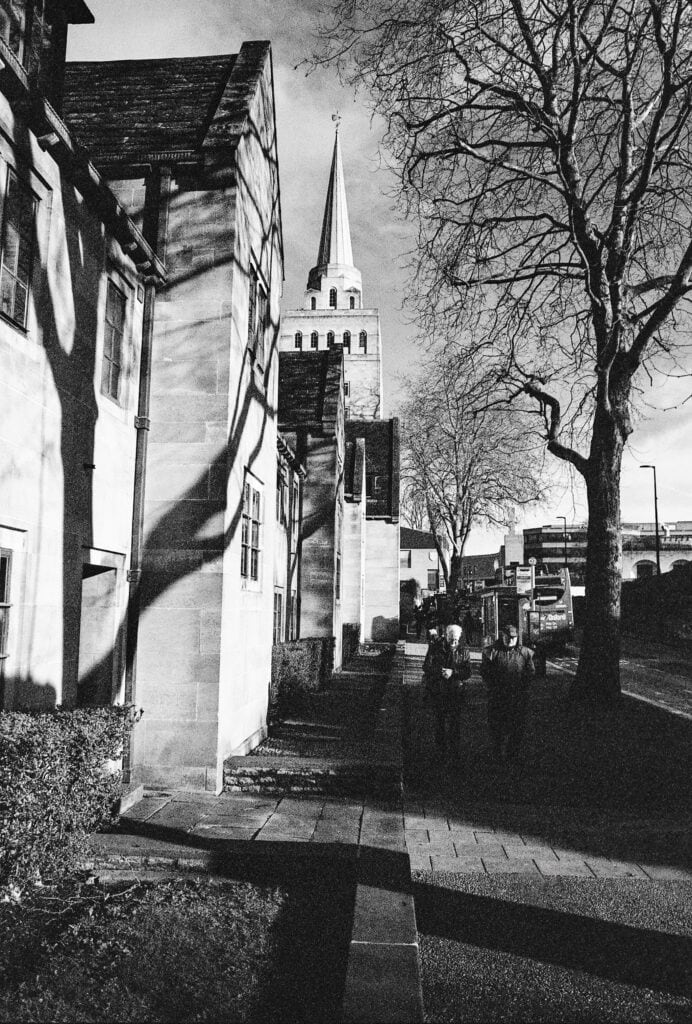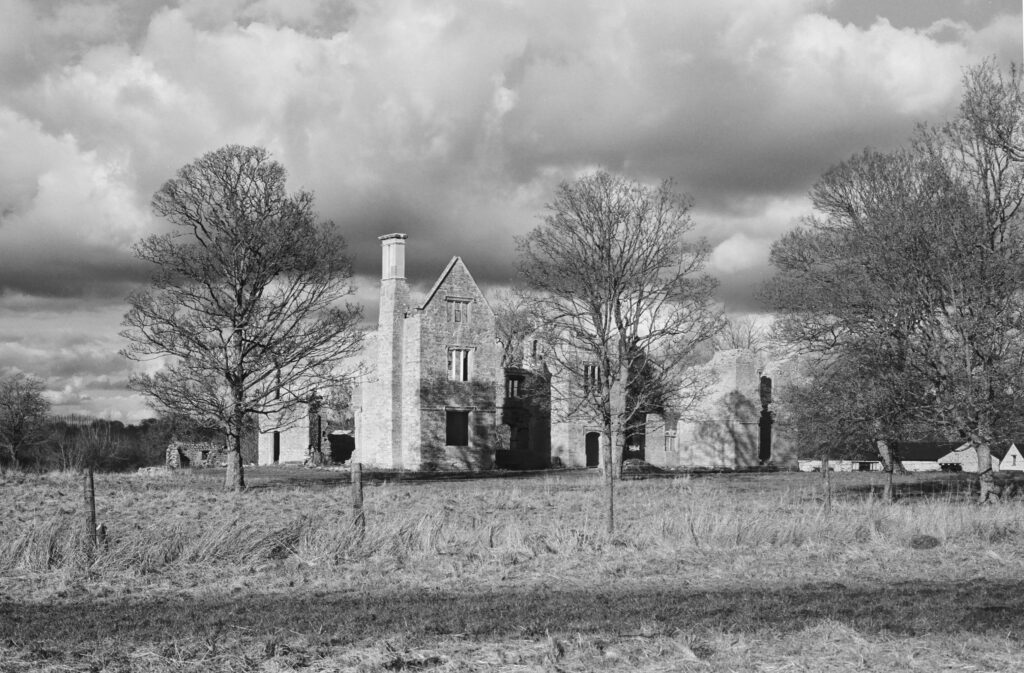The Nikon FE flew under my Nikon radar for many years. I regularly shoot with the FM3a, F3 and F6, and I’ve had a FM2/n in my collection for some years, but somehow I remained completely unaware of the FE. I am not sure why! When a very clean FM came up at a camera fair hosted by ImageX I examined it and saw from the serial number that it was wasn’t an FM at all – It was a Nikon FE. What exactly that meant was a mystery to me, but a few rolls of film and some reading later, I have got to grips with it.
The Nikon FE and FM – Major Differences
The Nikon FE is a semi-professional SLR model, manufactured from 1978 to 1983. The exterior is very similar to the Nikon FM introduced in 1977 but the internals are electronic. Neither camera features a model number on the front so they are easy to confuse.

Whilst they look alike, the FE and FM are quite different in two important respects and a few details. The Nikon FE has an electronic shutter and offers aperture-priority semi-automatic exposure mode. The centre weighted light meter makes use of needle matching in the viewfinder. The FM is all-mechanical (except for the light meter) and uses a “centre-the-LED” system.
In other words, the Nikon FE is essentially a Nikon FM with an added electronic shutter and aperture-priority mode. This is reflected in Nikon’s Product Timeline which describes the FE as “a sister model of the Nikon FM (1977) with Aperture-Priority Auto [A] mode.”
I am familiar with both metering systems from the FM3a (needle matching) and FM2/n (LEDs). My preference is for prefer needle matching over the LEDs (except in low light) and I usually shoot in full manual. The system is so easy and intuitive I don’t need auto mode. It really is a just personal preference, however. Plenty of photographers find the LEDs simpler and less distracting, and they are certainly easier to read in low light.
FE vs FM – The Details
There are a few other differences between the two models:
- Viewfinder Screen The FE has an interchangeable viewfinder screen, though the choice of replacements is limited to two (Types B and E, K comes as standard).
- Battery Check Indicator The FE has a dedicated battery indicator LED on the back of the camera. The FM’s light meter LEDs stay on.
- Mechanical Shutter Speeds The FE has two mechanical shutter speeds, 1/90 and B. The FM’s speeds are all mechanical.
- Auto Exposure Lock The FE has an AE lock lever. The FM does not offer this feature.
- Slowest Manual Speed The FE’s slowest manual speed is 8 seconds, compared to the FM’s 1 second.
- Exposure Compensation The FE, offering an automatic setting, offers exposure compensation, although the combined ISO/Exposure compensation is quite fiddly and there’s no indication in the finder that it is active. The FM, being manual, does not offer compensation – all adjustment is manual.
- Weight Nikon specifies 590g for the FE and 540g for the FM, making the FE slightly heavier.
- Serial Numbers FE serial numbers begin with 3000001 (prefixed by FE), FM serial numbers begin with 2100001 or 2100020 (prefixed by FM).

The Semi Professional Series
The similarities between the two models are unsurprising as the FE followed the FM in a series of small, semi-professional SLRs: the FM, FM2, FE, FE2, FA, FM3A. All these models shared the same rugged, copper-aluminium alloy (duralumin) internal chassis and general design ethos. An at-a-glance comparison of the FE and FM cameras is shown in the table below:
| FM | FE | FM2 | FE-2 | FM-2n | FM3A | |
| Shutter | Mechanical | Electronic | Mechanical | Electronic | Mechanical | Both |
| Automation | None | Aperture | None | Aperture | None | Aperture |
| Max. Shutter Speed (Sec) | 1,000 | 4,000 | ||||
| Flash Sync (Sec) | 1/125 | 1/250 | ||||
| Lens Compatibility Since | 1958 | 1977 | ||||
| Introduced | 1977 | 1978 | 1982 | 1983 | 1984 | 2001 |
| Discontinued | 1982 | 1983 | 1984 | 1987 | 2001 | 2006 |
Why the Nikon FE was Important
The Nikon FE was important to Nikon for two reasons. Firstly, the electronic Nikon F3 professional camera was already in the works and pro acceptance of electronic shutters was essential. These new shutters and the battery dependence they created were a major cause for concern for conservative pros. The Nikon FE had a popular reception and the positive press coverage it generated helped to overcome the negative sentiment towards electronic shutters that was current at the time.
Secondly, Nikon needed a competitive offering in the amateur/enthusiast market. At that time the market was shifting away from heavy mechanical camera bodies to more compact bodies with microprocessor electronic automation. Nikon a needed a camera to compete in that fast growing market segment. The Nikon FE’s electronic shutter allowed it to include automatic aperture priority and enabled Nikon to introduce it as a replacement for the older Nikkormat EL and Nikon EL series.

Shooting with the Nikon FE
Batteries are ready available. You can use a pair of button alkaline LR44s or a single lithium Duracell 1/3N. I chose the later option.
Loading film is straightforward. Once you have slid the safety lock towards the rear of the camera you can lift the film rewind knob. Raising the rewind knob completely pops the back of the camera back open. Load the film ensuring the perforations along the edges of the film mesh with the sprockets. When the film is engaged with the spool, press the camera back until it until it snaps into place.
The ISO film speed setting control is on the same ring as the exposure compensation control, on the right of the top plate. You depress the button to the right of the dial to set ISO and lift the ring to set the film speed. It works fine once you are used to it.
Looking through the viewfinder, the aperture you have selected is displayed in a small window to the top of the frame. This is the Nikon Aperture Direct Readout system. To the left there is a shutter scale that displays both the selected shutter speed and a light meter readout via a pair of needles. The longer, thinner black needle is connected to the light meter. In auto-mode this needle indicates which shutter speed will be used, whilst the thicker, shorter green needle is set it A.
In manual mode the green needle is set by the shutter speed dial and needs to be matched to the light meter reading shown by the other needle. You can adjust either the aperture or shutter speed to obtain a match. It’s a great system and in good lighting, I prefer it to the LED system of the F3 and FM2n. With needle matching I almost never use aperture priority as full manual seems so intutive.
The Next Generation
Nikon updated their compact SLR range with the release of the Nikon FM2 in 1982. The new model featured a much faster titanium shutter (1/4000th of a second vs the FM’s and FE’s 1/1000th), an enhanced light meter and an increased flash sync speed.
In 1983, Nikon introduced the Nikon FE2 with an improved shutter (same maximum speed but reduced shutter travel time) and improved damping. The following year Nikon updated to the FM2 as the FM2n, which took the improved shutter from the FE2. Later FM2ns adopted an aluminium shutter, presumably to reduce production costs.

The FE Vs FE2
The FE2’s biggest advantage over the FE is a 4x faster shutter, but the FE does have a few advantages of its own.
- Power Switch The FE’s power switch is very simple – just pull out the film wind handle. It’s a little more cumbersome on the FE2, the film advance lever has to be pulled open (to unlock the shutter release), followed by a half push of the shutter release. It then automatically shuts off to save power.
- Battery Test Light The FE has a dedicated battery test light, which the FE2 lacks
- Battery Life This FE uses less battery power than the FE2 because its faster shutter needs stronger shutter springs and the batteries have to power the electromagnets to cope.
- Non-AI Lenses The FE can use Nikon lenses going back to 1959, while the FE2 can’t use non-AI lenses.
- Pre Frame 1 Metering The FE2 light meter doesn’t engage until the counter on the film advance gets to 1. Before 1, the shutter always fires at its single manually operated shutter speed – 1/250th of a second. The FE does not have this feature, which is designed to prevent long exposures with the lens cap on, allowing the user to take a shot or two before frame 1.
Pros and Cons
Pros
- Intuitive needle matching light meter – especially useful in dynamic lighting conditions
- Aperture-priority semi-automatic exposure mode in a small, lightweight package
- Modern, automation equipped mount for non-AI lenses
- Dedicated battery test light makes it easy to see battery status
- Removable focusing screen provides some options
- Inexpensive to buy
Cons
- 1/1000 second maximum shutter speed can be a limitation in bright conditions (this can be overcome with filters of course)
Conclusion
I really enjoy shooting with the Nikon FE. It occurs to me that it is an ideal camera to get back to film with – suitable for beginners to experienced photographers. It isn’t going to replace the awesome FM3A in my affections, but it is a piece of Nikon history that is rewarding to shoot with, and, given its replacement value, one I am happy to take anywhere.
Thoughts and Further Reading
If have experiences to share with the Nikon FE, please leave me a comment below. I’d be delighted to hear from you. And if you are interested in classic or vintage cameras, there are articles on this site on:
- The Nikon F – Nikon’s first SLR
- The Nikon F3 Pro Camera
- The Nikon FM3A – Nikon’s last manual SLR
- The Nikon F6 – Nikon last film camera
- The Konica I – Konica’s first rangefinder
- The Kodak Folding No 2 Autographic Brownie
- Fox Talbot and Early Photography
- Wet Plate Photography
- From Chemistry to Computation (Photography timeline)
- Pictorialism
- Timeline of Early Cameras
If you’ve any experience with the Nikon FE, please leave me a note in the comments – I’d love to hear about it.